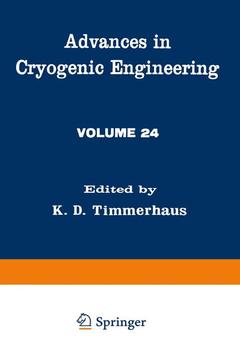Advances in Cryogenic Engineering, 1978 Advances in Cryogenic Engineering Series, Vol. 24
Langue : Anglais
Coordonnateur : Timmerhauso K.

The Second International Cryogenic Materials Conference (ICMC) was held in Boulder, Colorado, in conjunction with the 1977 Cryogenic Engineering Con ference (CEC). Special thanks must be given to the University of Colorado for their skillful hosting of these two conferences. Collaboration between the two con ferences has been mutually beneficial, providing the materials special ist with insight into new applications and design concepts and the cryogenic engineer with exposure to modern materials accomplishments and potentials. The Proceedings of the 1977 Cryogenic Engineering Conference are published in Volume 23 of Advances in Cryogenic Engineering. Both conferences will be held again simul taneously in Madison, Wisconsin, in August 1979. The success and growth of the two International Cryogenic Materials Con ferences have led to the formation of an ICMC Board of Directors. The board members will serve a four-year term and include: Chairman, R. P. Reed (U.S.), R. W. Boom (U.S.), A. F. Clark (U.S.), G. Hartwig (W. Germany), J. W. Morris (U.S.), M. Suenaga (U.S.), K. Tachikawa (Japan), J. Tanaka (Japan), and K. A. Yushchenko (USSR).
General Reviews.- A—1 Large Superconducting Magnets for New Energy Technologies.- A—2 Low-Temperature Properties of Epoxy Resins and Composites.- A—3 The Development of Cryogenic Materials Science in the USSR.- A—4 A Low-Temperature Materials Research Program for Magnetic Fusion Energy.- A—5 Composite Materials for Cryogenic Structures.- A—6 Summary of the International Discussion Meeting on Radiation Effects on Superconductivity.- A—7 Fatigue Crack Growth Resistance of Structural Alloys at Cryogenic Temperatures.- A—8 Fe-Mn Alloys for Cryogenic Use: A Brief Survey of Current Research.- A—9 Elastic Constants at Low Temperatures: Recent Measurements on Technological Materials at NBS.- Ferrous Alloys.- B—1 Low-Temperature Weldable Steels and Alloys.- B—2 Cryogenic Properties of a New Tough-Strong Iron Alloy.- B—3 The Suppression of Low-Temperature Intergranular Brittleness in Ferritic Fe-Mn Alloys.- B—4 Surface Film Effects on Deformation Behavior of Iron Single Crystals at Cryogenic Temperatures.- B—5 Evaluation of Weldments in Austenitic Stainless Steels for Cryogenic Applications.- B—6 Note on the Fracture Properties of Fe-49Ni at Cryogenic Temperatures.- Nonferrous Alloys.- C—1 Fracture Strength of Thick 5083-0 Aluminum Alloy for LNG Storage Tanks.- C—2 Metallurgical Problems of Welding 1201 (Al—6Cu—Mn) Alloy.- C—3 Environmental-Assisted Fatigue Crack Propagation in 3003-0 Aluminum.- C—4 The Influence of Processing and Heat Treatment on the Cryogenic Fracture Mechanics Properties of Inconel 718.- C—5 Experimental Analysis of Cracks in Thin Metal Plates.- Structural Alloys—Physical Properties.- D—1 Specific Heats of Some Cryogenic Structural Materials I—Fe—Ni—Base Alloys.- D—2 Magnetic Field Effect on Thermal Conductivity of Selected Metals.- D—3 Standard Reference Materials for Thermophysical Properties.- D—4 Diffuse Cluster Superparamagnetism in Inconel X750.- D—5 Temperature Dependence of Creep in F.C.C. and H.C.P. Metals at Low Temperature.- Composites.- E—1 Stainless Steel Fiber Organic Matrix Composites for Cryogenic Application.- E—2 Glass-Reinforced Epoxy Piping for Liquid-Nitrogen-Cooled, AC Transmission Cables.- E—3 Fiberglass-Epoxy in a Conical Superconducting Field Magnet Support.- E—4 Compressive Strength of Glass-Fiber-Reinforced Composites at Room Temperature and 77 K.- E—5 An Epoxy Fiberglass Tension Member Support for Superconducting Magnets.- E—6 Specific Heats of Some Cryogenic Structural Materials II—Composites.- E—7 Distribution of the Effective Thermal Conductivity in a Porous Insulation System Subjected to Internal Vapor Circulation.- Superconductors—Stress Effects.- F—1 Fatigue and Stress Effects in NbTi and Nb3Sn Multifilamentary Superconductors.- F—2 Evaluation of Large, Multifilament Nb3Sn Conductors with a New 12-Tesla Tensile Test Apparatus.- F—3 Influence of Tensile Stresses on the Superconducting Temperature of Multifilamentary Nb3Sn Composite Conductors.- F—4 Mechanical Properties of Multifilamentary Nb3Sn Superconductors.- F—5 Resistance to Strain Degradation in Preliminary UWMAK TF Coil Conductors for Fusion Reactors.- Superconductors—Pinning.- G—1 How Effectively Can Grain Boundaries Pin Flux Lines?.- G—2 Critical Currents in Thin Nb3Ge and Nb3Ga Films.- Superconductors—Multifilamentary.- H—1 Critical Current Density in Multifilamentary Composites.- H—2 High-Current Al-TiNb Composite Conductor for Large Energy Storage Magnets.- H—3 Fabrication and Properties of an Aluminum-Stabilized NbTi Multifilament Superconductor.- H—4 Performance of Multifilament Nb3Sn Conductors for High-Field Applications Prepared by Competing Processes.- H—5 Multifilamentary Nb3Sn Composites Incorporating a High-Tin Bronze.- H—6 Combined Transport Current and Transverse Field Losses in Multifilament Superconductors.- H—7 Alternating Field Losses in Filamentary Superconductors Carrying DC Transport Currents.- H—8 Superconductors for Tokamak Poloidal Field Coils.- Superconductors—Films and Tapes.- I—1 Preparation and Superconducting Properties of Thin NbN Films in Magnetic Fields.- I—2 Properties of Superconducting Nb3Sn Layers Used in RF Cavities.- I—3 Nb3Sn Conductors for AC Power Transmission: Electrical and Mechanical Characteristics.- I—4 Nb3Ge as a Potential Candidate Material for 15- to 25-T Magnets.- I—5 Nb3Ge and Nb3Sn Films Prepared by High-Rate Magnetron Sputtering.- Special Electrical Materials.- J—1 Evaluation of Metal-Foil Strain Gauges for Cryogenic Application in Magnetic Fields.- J—2 Dielectric Loss Spectrum of Hydrated Vitreous Silica.- J—3 Measurements of Mechanical and Electrical Properties of High-Purity Aluminum.- U.S./USSR Exchange Program on LNG Materials Research.- K—1 Mechanical Properties of Soviet and American Al-Mg Alloy Plates and Welds for LNG Systems.- K—2 Mechanical Properties of U.S./USSR Al-Mg Plate and Welds for LNG Applications.- K—3 Low-Temperature Fracture Properties of a USSR Aluminum—6% Magnesium Alloy.- K—4 An Evaluation of Three Steels for Cryogenic Service.- K—5 Investigation of Steels for Their Application in LNG Transportation and Storage Welded Systems.- K—6 Fracture Toughness of Cryogenic Alloys.- K—7 Fracture Mechanics Parameters for an Iron—13% Chromium—19% Manganese Stainless Steel and Its Welds at Cryogenic Temperatures.- Indexes.- Author Index.- Material Index.
Date de parution : 05-2013
Ouvrage de 586 p.
17x24.4 cm
Disponible chez l'éditeur (délai d'approvisionnement : 15 jours).
Prix indicatif 52,74 €
Ajouter au panierMots-clés :
Germany; cryogenics; design; energy; energy storage; engine; growth; material; materials; mechanics; radiation; superconductivity
© 2024 LAVOISIER S.A.S.



